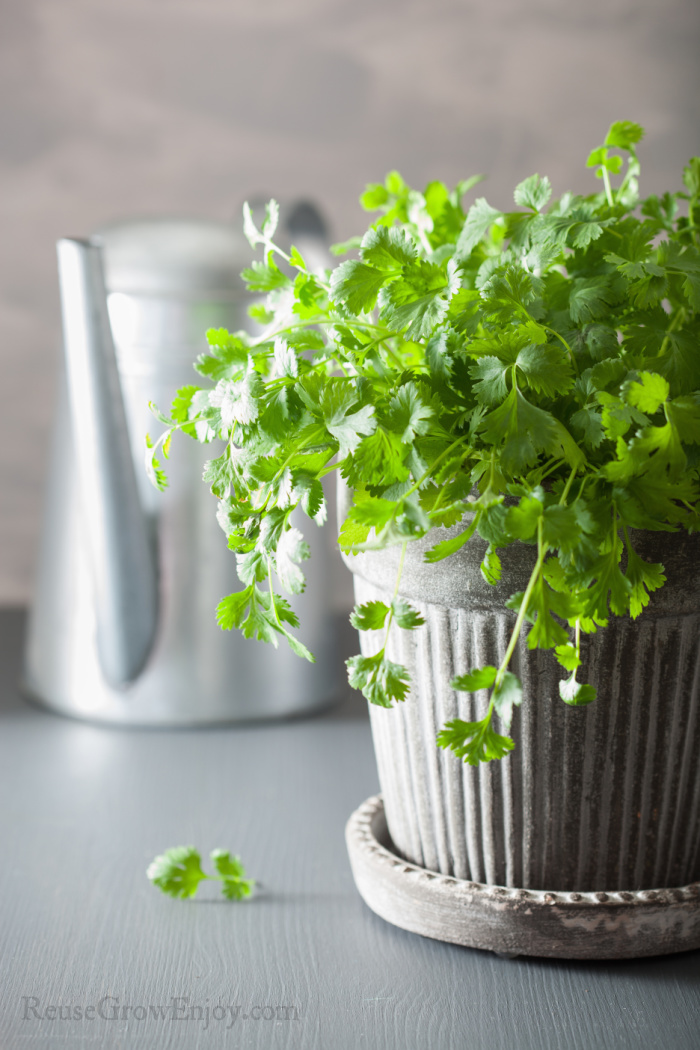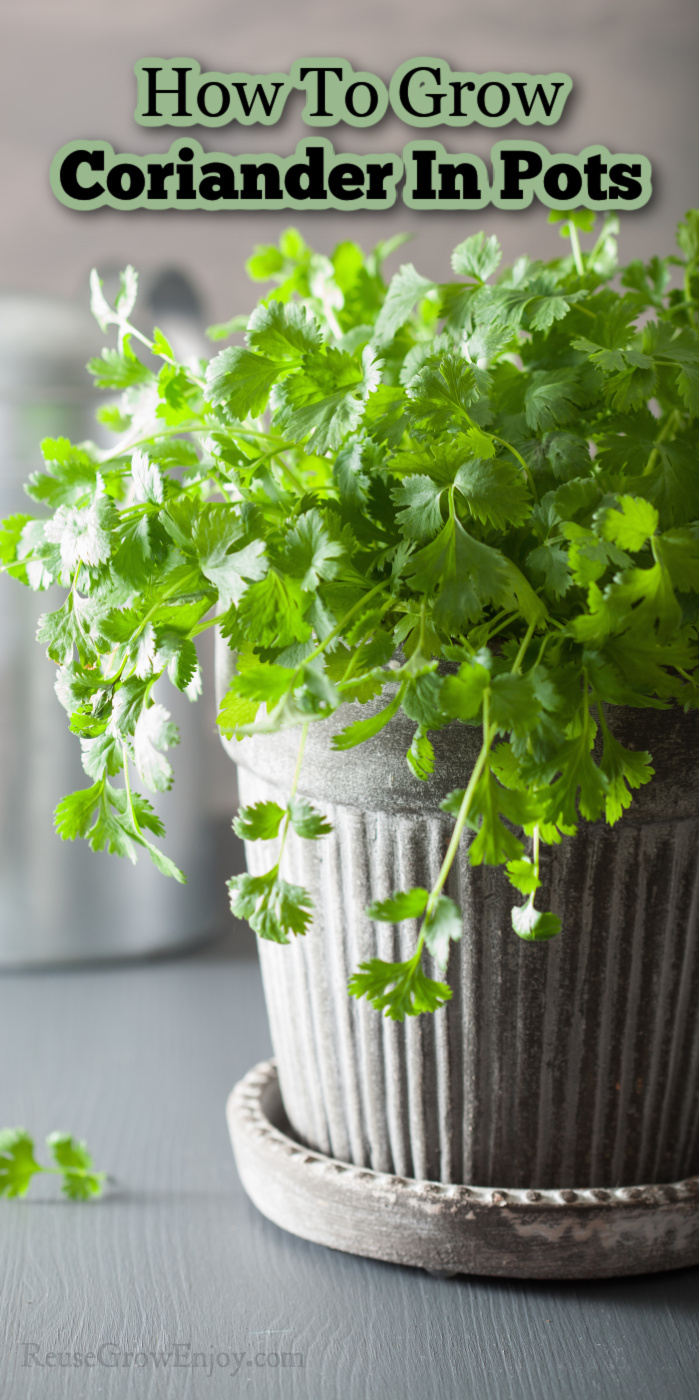Coriander is the seed of the cilantro plant and is easy to grow in an herb garden. Learn how to grow coriander in pots and care for it, cook with it, and use it for medicinal purposes.

Coriander is the name given to the seeds of an herbaceous plant (Coriandrum sativum) more commonly known as cilantro. Coriander seeds are small, ribbed, and nearly round, usually less than 1/8 inch in diameter.
They have a distinct aroma when crushed and a sweet, peppery flavor with a hint of orange when eaten. The cilantro seeds are considered to be spices, while the leaves fall under the category of herbs.
Both the seeds and leaves are used in cooking but taste completely different.
The cilantro plant grows to a height of approximately 24 inches and has two distinct types of leaves. The lower leaves are entire and toothed. While the upper leaves are somewhat lacy in appearance.
The leaves resemble Italian parsley, but the smell gives the cilantro plant away. The white, pinkish, or pale purple flowers resemble Queen Anne’s Lace.
They are members of the same plant family, the Umbelliferae. Parsley and carrots are also members of this plant family.
Before we dive into this guide and tips on how to grow coriander in pots, here are a few other posts you may enjoy.
- How To Grow Cantaloupe From Seeds
- Beginners Guide On What Herbs To Grow And Companion Planting
- How To Propagate Basil (aka Grow Basil From Cuttings)
Coriander Is Relatively Easy To Grow:
To cultivate coriander seeds, plant them in early spring, about 3 inches deep, in moist well-drained soil. The plant prefers a warm and somewhat dry climate and thrives in full sun, but will do well in partial shade.
Although it is an annual, it frequently reseeds itself in the garden, which makes it seem like a perennial. If not carefully watched, it can become a weedy pest.
Harvesting Coriander Seeds:
The seeds are ready for harvesting when they are dried, yellowish-brown in color, and crunch when pinched between two fingers. Cut off the top stems containing the seeds and place them in a paper bag.
Shake the bag vigorously or thump it against the side of the house to remove the seeds from the plant. Rinse the seeds with water then dry seeds be sure to allow them to thoroughly dry to prevent rotting or mildew. Store the seeds in a glass jar with a lid out of direct sunlight.
Uses:
Native to the Middle East and possibly to the Mediterranean, coriander seeds are used in cooking many Indian, Middle Eastern, Thai, and Indonesian dishes.
Coriander seeds are often made into a powder or coarsely ground with a mortar and pestle and mixed with cumin to create curries.
They are also used to season grilled meats such as pork, beef, lamb, and goat. Typically they are toasted to increase the flavor before being used.
Coriander seeds are also used as a pickling spice, as an ingredient in pastries, as a flavoring for liqueurs, and sometimes as a substitute for cardamom.
Coriander seeds add fiber to the diet and are a good source of iron and magnesium. They also contain flavonoids, powerful antioxidants found in plant pigments that minimize damage at the cellular level caused by free radicals.
Coriander seeds have some medicinal properties as well. The essential oil of coriander is distilled from the seeds and contains a compound called dodecanal.
It is one of several anti-microbial compounds found in coriander that helps fight off food-borne illnesses such as salmonella. Coriander is also thought to alleviate flatulence, stimulate the digestive system, and is sometimes used to mask unpleasant flavors of medicines.
Can I Grow Cilantro From Coriander Seeds?
Yes, as long as the seeds have not been treated in any way. Cilantro is the leaves of the plant also sometimes called coriander plant, which grows from the coriander seed. The flavor of cilantro leaves is often described as being parsley-like with a hint of citrus. Coriander seeds taste slightly sweet and are used to flavor desserts and candies.
Cilantro Cultivation Basics:
Coriander seeds are usually planted in pots or on the ground. Some gardeners prefer the hydroponic method and grow cilantro in water. Space seeds in the garden seeds 9 to 12 inches apart. The young plants need regular but moderate watering and full sunlight or artificial indoor light. Cilantro grows particularly well under intense fluorescent lights.
Germination & Plant Size:
Seeds normally germinate in seven to 10 days. Transplanting seedlings is discouraged as it may induce uneven growth. Full-grown coriander plants are between 18 and 24 inches tall.
Grow Coriander In Pots Considerations:
Cilantro plants are prone to self-sowing, so promptly remove any flowers to prevent a proliferation of plants the following season. Bees, birds, and butterflies often hover around mature plants.
Pests and Diseases:
The most common problems with this herb are things like pests. You will want to look out for aphids and mites. However, mildew is the number one disease that will kill this herb. This happens more often in humid, warm weather.
You can try and prevent powdery mildew with a few simple steps. First, make sure there is distance between the plants. This will provide enough room for good air circulation. Next, you want to avoid watering the plants from overhead. That is because when you wet the leaves, it promotes the growth of mildew and many other fungal infections. So be sure to water at the base of the plant.
How to Care for Cilantro Indoors:
Cilantro grows its best foliage during the cool late spring and early summer days. Hot weather causes the plant to flower while freezing weather kills the cilantro. Keeping a pot of the herb indoors year-round ensures that you have fresh cilantro available whenever you need it.
After cilantro flowers, the leaves lose their aromatic flavor, but you can harvest the seeds for use as coriander. Cilantro grows quickly, so start a new pot as soon as the old one flowers to keep fresh cilantro growing indoors.
Set the cilantro pot in a sunny windowsill that receives six hours of direct sunlight or more per day. Such as in a south-facing or west-facing window. Set a fluorescent to grow light fixture above the plant to supplement natural light if you don’t have a suitably sunny indoor area.
Water plants thoroughly when the top inch of the soil feels dry. Plants don’t tolerate overly moist or overly dry soil, so avoid overwatering and standing water in the pot or drip tray.
Fertilize cilantro every six weeks with a soluble nutrient solution formulated for herbs or foliage plants. Apply the fertilizer at the rate recommended on the label for the pot size.
Harvest cilantro once the stems are at least 3-4 inches tall. Cut back the stems as you need them from the outside of the plant. Cut back the entire plant by up to half its height when it’s between 6 and 8 inches tall. Periodically cutting the plant back encourages further foliage growth and prevents flower heads from forming.
If you want coriander seeds, stop cutting back the cilantro and allow it to flower. The seeds form after flowering. Harvest once the seed heads dry on the plant.
Frequently Asked Questions:
Q. Will cilantro or coriander come back each year?
A. Yes and No. It is an annual herb meaning it only grows for one growing season. However, you can keep growing from the same plant over and over. The best way to do that is to save the seeds to grow new plants each year. It is, however, a fast-growing annual plant so if you grow it indoors or are in a warmer climate if you spaced your planting times you can have a steady supply of cilantro all year. Also, with the proper conditions, if you allow the plant to seed outdoors, new plants will sometimes spring up during the next growing season.
Q. Can you plant it in plastic pots or does it need to be planted in clay pots?
A. These plants are really not that picky as long as you use a good potting mix and it has good drainage. You can even plant in a plastic bag if you wanted to. You would just need to make sure to make drainage holes in the bottom of the container.
Q. Do you have to live in a hot climate to grow?
A. No. While coriander/cilantro like warm weather it does not do well when it is super hot out. The plant will actually wilt if it is super hot.
Q. Why is my plant not growing well?
A. If your plant is not growing that well or not getting too large, you may want to consider moving it to a larger pot.



Leave a Reply